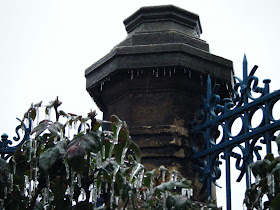
The snow has been back at intermittent periods, followed by icy rain which has created beautiful icicles suspended from every natural and man-made form.
In the Bleak Mid Winter
Christina Rossetti
In the bleak mid-winter
Frosty wind made moan,
Earth stood hard as iron,
Water like a stone;
Snow had fallen, snow on snow,
Snow on snow,
In the bleak mid-winter
Long ago.
Our God, Heaven cannot hold Him
Nor earth sustain;
Heaven and earth shall flee away
When He comes to reign:
In the bleak mid-winter
A stable-place sufficedThe Lord God Almighty,
Jesus Christ.
Enough for Him, whom cherubim
Worship night and day,
A breastful of milk
And a mangerful of hay;
Enough for Him, whom angels
Fall down before,
The ox and ass and camel
Which adore.
May have gathered there,
Cherubim and seraphim
Thronged the air,
But only His mother
In her maiden bliss,
Worshipped the Beloved
With a kiss.
What can I give Him,
Poor as I am?
If I were a shepherd
I would bring a lamb,
If I were a wise man
If I were a wise man
I would do my part,
Yet what I can I give Him,
Give my heart.
In the Bleak Mid Winter was one of the poems written by Christina Rossetti in the latter part of the19th century. It was to be set to music, initially by Gustav Holst and later by Richard Drake and is one of my favouriteChristmas Carols.
Follow the link below to listen to the choir of King's College Cambridge singing it...
http://www.youtube.com/watch?v=_hs9-Sxf9j4&feature=related
The 29th Deceember is the date on which Christina Rossetti died in 1894, her grave being in Highgate Cemetary. Although Christina Rossetti is perhaps better known as the sister of the Pre-Raphaelite painter Dante Gabriel Rossetti, she was a recognized artist in her own right as a poet.
 |
| Christina Rossetti |
 |
| The Girlhood of Mary Virgin; Gabriel Dante Rossetti 1848-49 |
 |
| Ecce Ancilla Domini; Rossetti |
Elements of repression and restriction are reflected in her fairy story Goblin Market whist her own concerns about female fellowship were put into action through her volunteer work with fallen women at St Mary Madgalene's penitentiary. Rossetti devoted much of her life to her family and not surprisingly she had exacting standards regarding those who were to enter the family sphere.
 |
| Gabriel Dante Rossetti |
Dante Gabriel Rossetti was forever drawn to the writing of the 14th century Italian poet Dante Alighieri - especially the agonised love between Dante and Beatrice in The Divine Comedy as a source of inspiration to creativity. To a certain degree Rossetti replicated this duality in his relationship with his muse and long-term lover, the model Lizzie Siddal.
 |
| Ophelia - John Everett Millais 1851-1852 |
 |
| Beata Beatrix 1870 |
 |
| Lizzie; Rossetti |
.....He feeds upon her face by day and night,
And she wIth true kind eyes looks back on him,
Fair as the moon and joyful as the light;
Not wan with waiting, not with sorrow dim;
Not as she is, but was when hope shone bright;
Not as she is, but as she fills his dreams.
Despite her own artistic talent, recognized by the art critic John Ruskin, Lizzie's potential was forever hampered by ill health, depression and rather erratic lifestyle.
Lizzie did, however, inspire many works herself, and perhaps the most famous of these was Beata Beatrix, painted after Lizzie's death. Her ethereal beauty continued to haunt Rossetti even after her demise and this haunting image was maintained by legend... Rossetti had her coffin exhumed so that he could recover poetry buried with his muse. The face was said to be ever-beautiful to behold, and the striking red hair had continued to grow after Lizzie had left this world...
Her grave is to be found in Highgate Cemetery, as is that of Christina Rossetti...




No comments:
Post a Comment
Leave a message - please share your ideas!